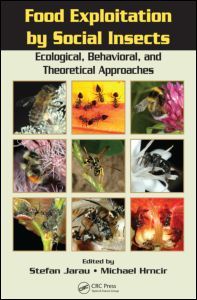Food Exploitation By Social Insects Ecological, Behavioral, and Theoretical Approaches
Coordonnateurs : Jarau Stefan, Hrncir Michael

Omnipresent in virtually all terrestrial ecosystems and of undisputed ecological and economical importance, the study of social insects is an area that continues to attract a vast number of researchers. As a consequence, a huge amount of information about their biology and ecology has accumulated. Distilling this scattered information into a highly focused reference, Food Exploitation by Social Insects: Ecological, Behavioral, and Theoretical Approaches unites traditional behavioral and ecological studies with theoretical and mathematical models.
The book covers foraging ecology and behavior of social insects, their communication mechanisms, and theoretical models of important aspects. It examines two different but inseparably interlaced levels of social insect foraging: the macroscopic or colony level and the microscopic or individual level. The chapters include discussions of foraging decisions, patterns and strategies of social insect colonies, and information use and information transfer between workers. The book provides examples of how this biological knowledge can be used as a basis for the construction of mathematical and neural network models that in return may increase understanding of social insect foraging.
The contributors provide a fresh look on their topics, covering a wide range of subjects and recent scientific developments that are unprecedented in breadth and depth. The coverage of ants, bees, and wasps in one resource is a unique feature of the book. This taxonomic content combined with the variety of research approaches, allows the book to provide deeper insight into the subject.
Measuring the Adaptiveness of Social Insect Foraging Strategies: An Empirical Approach. Social Cues and Adaptive Foraging Strategies in Ants. Individual and Social Foraging in Social Wasps. Season-Dependent Foraging Patterns: Case Study of a Neotropical Forest-Dwelling Ant (Pachycondyla striata; Ponerinae). Foraging Range and the Spatial Distribution of Worker Bumble Bees. How to Tell Your Mates: Costs and Benefits of Different Recruitment Mechanisms. Social Information Use in Foraging Insects. Local Enhancement, Local Inhibition, Eavesdropping, and the Parasitism of Social Insect Communication. The Role of Scents in Honey Bee Foraging and Recruitment. Trophallaxis: A Mechanism of Information Transfer. Mobilizing the Foraging Force: Mechanical Signals in Stingless Bee Recruitment. Chemical Communication During Food Exploitation in Stingless Bees. The Use of Scent Marks by Foraging Bumble Bees. Information Transfer and the Organization of Foraging in Grass- and Leaf-Cutting Ants. An Evolutionary Simulation of the Origin of Pheromone Communication. Mathematical and Neural Network Models of Medium-Range Navigation During Social Insect Foraging. Social Insects and the Exploitation of Food Sources: Concluding Thoughts. Index.
Date de parution : 05-2009
17.8x25.4 cm
Date de parution : 10-2019
17.8x25.4 cm
Thèmes de Food Exploitation By Social Insects :
Mots-clés :
Honey Bee; Stingless Bees; Bumble Bees; Scent Marks; Social Insects; Foraging Bumble Bees; Bee Foraging; Trail Pheromones; Bumble Bee Species; Bombus Terrestris; Active Foragers; Social Insect Colonies; Local Enhancement; Pheromone Communication; Foraging Ranges; Tetragonisca Angustula; Colony Level; Eusocial Insects; Trail; Ower Species; Hive Bees; Honey Bee Forage; Antennal Lobe; Marked Bees; Oral Scent



